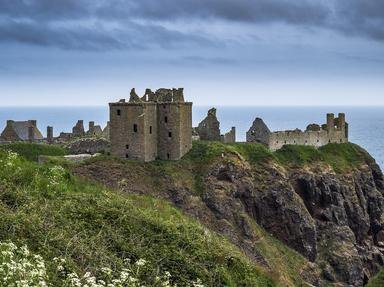Quiz Answer Key and Fun Facts
1. Your journey begins close to the town of Galashiels in the Scottish Border, where you visit Abbotsford House, once the home of the author of the series of books called the "Waverley" novels. Who lived there in the early nineteenth century?
2. Your visit continues with a visit to Scotland's capital city, Edinburgh, where you climb a hill overlooking the Palace of Holyroodhouse. What is its name?
3. While in Edinburgh you stroll along the Royal Mile, gazing up at the high buildings in the Old Town. What are these tenements called?
4. Across the River Forth from Edinburgh you reach a town once famous for the manufacture of linoleum. Which Fife town have you reached?
5. Travelling to the east end of the Kingdom of Fife as the county is still known locally, you reach a town distinguished for academic life and its hosting of the world governing body of the sport of golf. What is the name of this town?
6. Travelling north from Fife along the M90 motorway, near Perth you cross the Friarton Bridge over the longest river in Scotland. Which river are you crossing?
7. Your next stop takes you to a city once renowned for "Jute, jam and journalism". Which city is this, the fourth largest in Scotland?
8. As you head into the Highlands you see a number of very high mountains that you are told are known as Munros. How high does a mountain have to be to be classified as a Munro?
9. As you pass through the Highlands you reach the village of Aviemore, a centre for hill-walkers in summer and skiing in winter. In which National Park is it situated?
10. Going north from Aviemore you reach a city nicknamed "the capital of the Highlands". Where are you now?
11. Time to go seriously north, over the water to Shetland. Every January the islanders hold a spectacular festival called Up Helly Aa. The climax of a great procession is the burning of a model of what kind of ship?
12. South of Shetland lie the islands of Orkney. Between two of these islands, Westray and Papa Westray, is the shortest scheduled commercial air route in the world. How long does the flight take?
13. Leaving the northern isles of Shetland and Orkney you travel south until you reach yet another island. The main town on the island, Tobermory, was used as the location for the children's television show "Balamory". Which island are you visiting?
14. Back in the central belt you head for the city of Glasgow, where you visit a sports stadium which hosted football (soccer) matches in the 2012 Olympics and athletics contests in the 2014 Commonwealth Games. What is the name of the stadium?
15. Before leaving Scotland you take a trip to the town in which the poet Robert Burns died in 1796. Which town is your final destination?
Source: Author
Quizaddict1
This quiz was reviewed by FunTrivia editor
Pagiedamon before going online.
Any errors found in FunTrivia content are routinely corrected through our feedback system.

